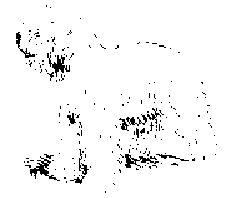Polish Lowland Sheepdog
General Information - Polish Lowland Sheepdog

Group:
Working
Size:
Medium
Lifespan:
12-15 years
Exercise:
Medium
Grooming:
High
Trainability:
Low
Watchdog Ability:
Medium
Protection Ability:
Low
Area of Origin:
Poland
Date of Origin:
1800s
Other Names:
Polish Owczarek
Nizinny, Valee Sheepdog, Berge Polonais De Vallee)
Original Function:
Sheep herder
History
The Polish Lowland Sheepdog derives its name because it worked on the lowland plains of Poland. It is likely that this medium-sized, robust sheepdog evolved from ancient, corded herding dogs from the Hungarian plains, which were bred with other small, long-coated mountain herders. The damage of World War II very nearly led to the breed's extinction. This breed was revived by diligent Polish breeders after World War II. Popular in Poland and elsewhere, it is generally kept as a household companion, although it remains an excellent herder.
Temperament
The Polish Lowland Sheepdog is an active friendly dog. The Polish Lowland Sheepdog is excellent with children when raised with them from puppyhood, and can be friendly with other dogs; but they will hold their own if another dog tries to knock them out from being the leader. They will usually do okay with other non-canine pets. As a working dog for many centuries, it is happiest when it is given a job to do. This breed is lively and clever enough to work sheep alone. This cute, shaggy dog does not grow into a calm, little lap-dog. This breed needs an owner who is firm and consistent. Socialisation and training are important.
Upkeep
The Polish Lowland Sheepdog needs daily exercise, either a moderate to long walk or a vigorous romp. It particularly enjoys herding. It can live outside only in temperate to cool climates, but would prefer to have access to the house. Its coat needs brushing or combing every other day, or it may form mats.
Polish Lowland Sheepdog
A breed standard is the guideline which describes the ideal characteristics, temperament, and appearance of a breed and ensures that the breed is fit for function with soundness essential. Breeders and judges should at all times be careful to avoid obvious conditions and exaggerations, as well as being mindful of features which could be detrimental in any way to the health, welfare or soundness of this breed.
Breed Standard - Polish Lowland Sheepdog 
General Appearance: Medium size, cobby, strong, muscular, fairly long thick coat.
Characteristics: Lively but self:controlled, watchful, bright, clever, perceptive with excellent memory. Easy to train, works as a herding and watch dog.
Temperament: Alert, equable.
Head and Skull: Medium size, proportionate to body, not too heavy, carried moderately low. Profuse hair on forehead, cheeks and chin make head appear larger than it is. Proportions of occiput to stop and stop to nose approximately equal, but muzzle may be fractionally shorter. Skull moderately broad, slightly domed, furrow from stop to occiput apparent when handled. Well defined stop. Nose blunt, wide opened nostrils, colour dark as possible.
Eyes: Medium size, lively penetrating gaze, oval shaped. Colour hazel to brown. Eye rims as dark as possible, closely fitting and showing no haw.
Ears: Medium size, heart-shaped, large at base and set moderately high, drooping with fore edge close to cheeks.
Mouth: Jaws strong with a perfect, regular and complete scissor bite, ie the upper teeth closing overlapping the lower teeth and set square to the jaws. Strong and evenly placed teeth. Lips tightly closed and as dark as possible.
Neck: Strong, muscular, medium length without dewlap.
Forequarters: Shoulders well placed with good lay:back, muscular. Legs when viewed from front or side, straight with slightly slanting pastern.
Body: Rectangular rather than square when viewed from side. Deep brisket with moderate spring of rib, neither flat nor barrel shaped. Withers distinctly marked; back level, muscular, with broad loin. Belly slightly drawn up. Croup short and slightly sloping. Proportions - Height to length as 9:10.
Hindquarters: Well angulated, with broad and well muscled thigh. From behind, legs straight, turning neither in nor out. Hocks strong and distinctly angled.
Feet: Oval, slightly arched but tightly fitting toes, with hard pads, nails dark. Hind dewclaws should be removed.
Tail: Customarily docked if not born Tail-less.
Gait/movement: Smooth walking or trotting. Inclined to amble.
Coat: Whole body covered with long, dense, shaggy thick coat of harsh texture with soft undercoat. Long hair covers eyes. Slight wave permissible. No loose skin anywhere on body.
Colour: All colours acceptable.
Size: Dogs 43 to 52 cms (17 to 20 ins); Bitches 40 to 46 cms (16 to 18.5 ins).
Faults: Any departure from the foregoing points should be considered a fault and the seriousness with which the fault should be regarded should be in exact proportion to its degree.
Note: Male animals should have two apparently normal testicles fully descended into the scrotum.
DNZ No 538
Copyright Dogs New Zealand
19 Dec 2013
Any departure from the foregoing points should be considered a fault and the seriousness with which the fault should be regarded should be in exact proportion to its degree and its effect upon the health and welfare of the dog and on the dog’s ability to perform its traditional work.





